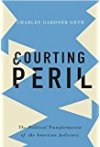
Reviewed by: James G. Apple, Editor-in-Chief, International
Judicial Monitor
Since its founding the late 18th Century, one of
the “rocks” on which has been built the United States legal system is the “rule
of law.” That phrase has been used by statesmen, politicians, judges, law professors – almost
anyone connected with the legal system and administration of justice - for over
220 years. The phrase includes, within its meaning, the concept of an “independent
judiciary,” also a staple of American legal thought during the same time
period.
In his new book University of Indiana law professor Charles
Gardner Geyh, described the rule of law paradigm:
The traditional conception of the judicial role
in American government is an essential component of a large rule of law
paradigm. It is a role that features competent, honest, impartial, and
independent judges who interpret and apply the rules that we the
people have created to govern ourselves, by bracketing out
extralegal influences within and without, and following the law on a case-by-case
basis.
The reason for this book is the need to examine the validity
of that paradigm in the contemporary United States, and to suggest an
alternative for a “changing landscape.” Geyh discusses in much depth the
reasons why the rule of law paradigm is becoming frayed and declining
usefulness. He promulgates a new paradigm, one that more accurately supports
what judges actually do, one that he calls the “legal culture paradigm” This
change is needed, he posits, because the clinging to the rule of law paradigm
at a time when it does not reflect judicial reality, is the source of much
uneasiness and angst in the body politic. The rule of law paradigm does not now
fit what judges do and represents in actuality hypocrisy. “Discomfort with that
hypocrisy is on the rise,” he observes. The development of a new paradigm is
needed of the U.S. court system is to remain strong and respected.
Part of the problems that have arisen in connection with the
rule of law paradigm, as suggested by the title to this book, is the increasing
infringement on the selection of judges and the operation of courts by politics
and politicians. There have always been fault lines among the three branches,
and the most serious and obvious one has been that between the judiciary and
the other two branches of government, namely the executive and the legislative.
In his Introduction, Geyh points out that many observers and
commentators view the present situation of the influence of politics on judicial
actions and selections with increasing alarm, and consider the situation as one
of crisis in both the federal and state courts. The alarmist viewpoint is that
the courts and judges are at the brink of disaster; that the traditional
paradigm is on the verge of collapse. Another alternative viewpoint, one that
is diametrically opposed to the cry of calamity, is that the situation is not
all that bad, that courts and judges are pretty much carrying on business as
usual, and that there is no cause for alarm and calls for radical change. This
book, the author states, explores a third possibility, that of a “legal
culture” paradigm.
Gehy explains in the second chapter of the book his use of
the term “paradigm.” The word was originally made popular by scientist Thomas
Kuhn in his authoritative and influential book, The Structure of Scientific
Revolutions (1962). Gehy describes it and its use in science as follows:
In Kuhn’s schema, scientists in given field
organize their thinking around dominant models or paradigms that
synthesize and describe how their piece of the world works to the
satisfaction of those who study it. The prevailing paradigm structures how
a field of study is conceptualized until practitioners within the
field identify anomalies that the paradigm cannot explain. These
practitioners struggle to rationalize
such anomalies within the framework of the existing paradigm until a critical mass
concurs that the paradigm is unsustainable. As the old paradigm crumbles, the hunt begins for a new,
more satisfactory paradigm that can explain what the predecessor
could not. When found, the relevant scientific community shifts its
focus to developing the new paradigm, until that paradigm crumbles
and gives way to a successor. Hence, Copernicus yielded to
Newton, who yielded to Einstein.

 International
Judicial Monitor
International
Judicial Monitor